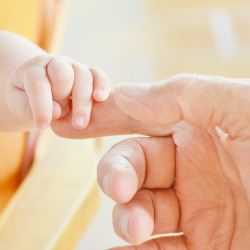As the Supreme Court gears up to determine “the fate of the fetus,” the state of their “pre-genitors” also remains murky.
The cryopreservation technology to freeze egg, sperm, and embryos was developed in the 1990s. Freezing the cells in liquid nitrogen cools them to -196C (-320 F), literally “freezing” or stopping all biological processes. Evidence suggests that the duration of storage does not affect survivability. The technique seemed a godsend for young folks about to undergo chemotherapy which might destroy their childbearing ability– allowing them to preserve, untainted, their potentials for progeny. The medical indications for this technology have given way to social uses - wanna-be Moms who wanted to delay childbearing while pursuing careers were given the choice to do so. Now gamete selection is procurable remotely by catalog, and selected cryo-preserved egg or sperm can be shipped to waiting gestators miles and countries away
Initially, oocyte (egg) stimulating hormones were designed to produce as many eggs as possible. As many embryos “failed” during the thawing process or didn’t survive implantation or gestation, “backups” were needed. Fertilization of multiple embryos became the objective.
“According to the American Society of Reproductive Medicine (ASRM), the pregnancy success rate for egg freezing is … around to 2 to 12 percent per frozen egg.”
Dr. Alexix Heng Boon Chin
The unintended downside of this “backup” solution resulted in millions of unused fertilized eggs remaining suspended in deep freeze around the world while their donors debate their future fate. In Israel, about 300,000 unclaimed frozen embryos reside in cold storage, along with billions of sperm. In the US, as of 2017, a million embryos remained on ice. Maintenance costs range from $500 to $1000 a year.
But often, donors disappear, avoiding the decision to dispose of or donate their surplus gene products – and the continued cost to maintain them. IVF facility managers want to clear their shelves of “unused stock” – but fear liability claims from donors. This technology, like no other, has birthed so many issues involving responsibility for care, control, and disposal – with no answers.
The problem is confounded when once-happily mated pairs dissolve before their potential progeny is activated. Who gets custody of the embryo? Can one donor unilaterally decide to donate it for research, adoption, or disposal if the other opposes the decision? Variations in international legal responses further complicate the problem – a problem sure to be encountered more often as gamete selection increasingly transcends borders. Given that many countries outlaw IVF for single women, the market for international gamete transfer is ripe. [1]
And finally, perhaps the ultimate question: Should there be a legal limit on how long the material can be kept since Blastocysts, frozen (at the 8-16 cell stage ), [2] can survive for decades. Should a potential parent be allowed to suspend the animation of their potential progeny for a half-century or more- spawning the perverse vision of octogenarians raising the next generation? Such allowances will also enable deferring the decision-making for disposal or use for a half-century or more, allowing the backlog of unused embryos to mount.
“This is one of the unintended consequences of IVF that doesn’t get a lot of attention,”
Barbara Collura, President, CEO of RESOLVE: The National Infertility Association.
Assisted reproductive methodologies, IVF and its counterparts remain mostly unregulated in the US, so a domestic legislative solution doesn’t seem to be in the offing. Once noble suggestions offered to pre-parents- such as donating eggs for adoption - isn’t very viable anymore either.; as IVF techniques advance, the call for adopted embryos has fallen. And as one tormented egg-donor agonized, even the research for which the material might be donated is usually limited to mundane issues such as maintaining quality control in IVF labs.
Even as the conundrum of excess embryos lying dormant continues to agonize so many, the UK, which does regulate all phases of IVF via the Human Fertilisation and Embryology Authority (HFEA,) recently announced planned changes which include extending the shelf-life for embryos frozen for social purposes (i.e., delayed childbearing) to 55 years, giving it parity with embryos frozen for medical reasons.
This “might become the ultimate graduation gift for children of families who could afford it.”
Dr. Gillian Lockwood in the Telegraph,
Objections to these proposed changes were intense, including “moral panics over 'macabre, nightmare scenarios' of 75-year-old women attempting motherhood for the first time,” as reported in the UK Daily Mail. These claims were rejected by proponents, claiming that “while there is no legal maximum age for IVF treatment in the UK, very few fertility clinics will treat a woman over 50 anyway.” However, a reduced likelihood of a feared consequence doesn’t mean that it won’t happen. The new change was supposedly proffered to allow women to freeze their eggs should their current progeny prove infertile [3], allowing a prospective grandmother to continue her genetic lineage in the form of a frozen-egg bequest to infertile daughters, but nothing limits it to this use.
A debate rages even among proponents to target the procedure to women in their twenties, with “biologically optimal” eggs, who “yield” a higher quality of egg and might want a longer time to decide when or whether to use them. A woman in her late twenties might want another twenty years before deciding to become a mother so as not to derail her career. The present law doesn’t allow her that freedom, so many consider the planned change a victory.
But is it?
Embryo disposition is “a significant and frequently unresolved issue for couples with stored frozen embryos,” complicated by “their deeply personal conceptualizations of their embryos” which “contributes to their ambivalence, uncertainty, and difficulty in reaching a decision.”
Dr. Robert Nachtigall, UC San Francisco.
The planned law will subject these new donors to the dilemmas of disposal. This agonizing quandary sure to confront any women utilizing the technique is entirely ignored. And then there are the financial considerations. A yearly maintenance fee of $1000 maintained for 55 years is surely not inconsequential – could that money be put to better use? Does the entire scheme favor the wealthy? I won’t even embark on a full discussion of the moral issues triggered: creating pre-persons -- “just-in-case” someone can’t be a biological grandmother.
On a cost-basis (or use-non-use basis), is the new schema beneficial to society? Most studies suggest that only four to six percent of women who freeze their eggs for delayed childbearing use them, with half that number being successful- i.e., resulting in live births. For this minute slice of society, one wonders if we should be subjecting the remainder to such costs, expense, and emotional agony?
Surely, this is an example where technology has run away with our imagination. Just because we can do something- doesn’t mean we should.
[1] As a result of a decrease in the decline in birth rates, an argument is currently raging in Singapore whether to lift the ban on social-egg freezing for women.
[2] At the 16 cell stage, usually day 5 or 6 after fertilization, freezing generally takes place, and the entity is called a blastocyst before maturing into a “blastomere” or morula (little mulberry). “Pre-embryo” is the term generally used to describe the fertilized egg or zygote during the first two weeks of its existence. After that, it officially becomes an embryo until its 8th week, when it is called a “fetus.”
[3] “The new limit was proposed so that mothers of newborn girls with Turner Syndrome (a genetic condition causing very premature menopause) could store their eggs for their daughters to use much later.” Dr. Gill Lockwood

